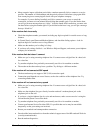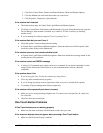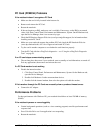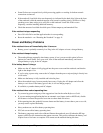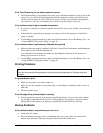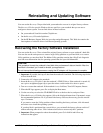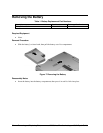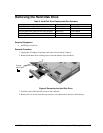
28 Troubleshooting and Diagnostics ze1000 Series Troubleshooting and Self-Repair Guide
10. After each run, press F2 to go back to the advanced tests screen, press F4 to view the support
ticket, or press F3 to exit.
e–DiagTools for Windows can update the version of e–DiagTools on your notebook’s hard disk. In e–
DiagTools for Windows, use the e–DiagTools menu.
If you have trouble running e–DiagTools from the hard disk, you can also run it from the Recovery
CD or DVD. Boot from disk 1 and select the diagnostics option.
Using the BIOS Configuration Utility
The BIOS (Basic Input and Output System) configuration utility enables you to change the notebook’s
system configuration, and to tailor the operation of your notebook to your individual work needs.
1. Restart the notebook: click Start, Turn Off Computer, Restart.
2. When the HP logo appears, press F2 to enter the BIOS configuration utility.
3. The pointing devices are not active in the BIOS configuration utility, so you will need to use the
keyboard to navigate:
• Press the left and right arrow keys to move among menus.
• Press the up and down arrow keys to move among parameters in a menu.
• Press Enter to open the dialog for the current parameter, or to select the parameter.
• Press Tab or the left and right arrow keys to move among selections in a dialog.
• Press the up and down arrow keys to move through values for the setting.
• Press Enter to close the dialog and accept the settings.
4. When you finish making changes, press F10 (or select Exit, Save and Reboot).
5. Press Enter to confirm and restart the notebook.
The following tables describe the settings for the notebook’s initial BIOS release. If your notebook’s
BIOS version is different, some settings may differ from those shown, or may be absent.



